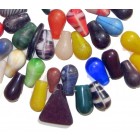“Mali Wedding Beads” collectively refers to a variety of bulbous and colorful Czech trade beads manufactured in Bohemia (now Czechoslovakia) between the 19th and 20th century. Their name derives from the popularity among the Fulani people of Mali, who traditionally present them to their daughters on the eve of her wedding.

Mali Wedding Beads
Mali Wedding Beads are among the earliest types of Bohemian trade beads to be produced using the mechanical pressing method, originally patented in France by Jean-Felix Bapterosses in 1843. Molten glass is distributed into molds, then fired under pressure to achieve a uniform shape. Pressed beads typically have a visible seam running the entire perimeter of the bead, although in the case of Mali Wedding Beads, was often ground down by hand to achieve a smooth finish.
“Fulani Wedding Beads”, as they are also known, come in a wide range of sizes and shapes. The most common varieties resemble pineapples and light bulbs, with a horizontal perforation at the top, however, they were also produced in triangular and ‘claw’ shapes. Hourglass and pineapple beads are highly prized by women of the Fulani tribe, since they closely resemble the female form. In rural parts of Mali, such beads are still believed to aid female fertility.
Early Mali Wedding Beads were typically produced in opaque, single colors, however, as technology advanced, Czech glass-makers began to experiment with different combinations to produce both striped and speckled varieties. Today, Mali Wedding Beads can be found in just about every shade of the spectrum, with a wide range of effects and finishes.
